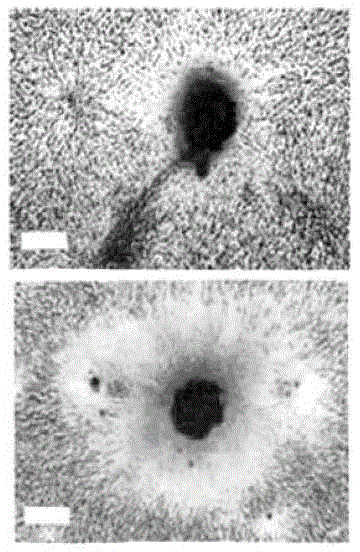Cryopreservation protective agent for vitrification cryopreservation of marrow mesenchymal stem cells
A bone marrow mesenchyme and vitrification cryopreservation technology, which can be used in applications, preservation of human or animal bodies, animal husbandry, etc., can solve problems such as cytotoxic damage, ice crystal mechanical damage, protective agent permeability damage, etc., to improve recovery rate, reduce the content, and reduce the effect of cytotoxic damage
- Summary
- Abstract
- Description
- Claims
- Application Information
AI Technical Summary
Problems solved by technology
Method used
Image
Examples
Embodiment 1
[0031] Such as figure 1 As shown, a cryoprotectant for vitrification of bone marrow mesenchymal stem cells, including 8.2% osmotic protection solution, 0.8% monosaccharide, 20% human serum albumin, 2.1% Rho inhibitor , the remaining components are physiological saline, and the Rho inhibitor is Y-27632.
[0032] Experimental cryopreservation materials: animal, 2-year-old Beagle dog, male, weighing 22.7kg.
[0033] experimental method:
[0034] Step 1: Extract bone marrow, purify and isolate mononuclear cells, inoculate and culture the primary cells for 48 hours, and inoculate them with 10 mmol / L of dexamethasone, 2.16 g / L of β-glyceroglycerophosphate and 37.5 mg / L of 2 - Ascorbic acid phosphate culture medium, 5% CO 2 In an incubator, culture at 37°C for 8 days; use 0.25% trypsin-0.02% EDTA culture solution for the first passage; use 1.6×10 4 / cm 2 The cell density was inoculated and cultured to the P2 generation.
[0035] Step 2: Add the protective agent of this example ...
Embodiment 2
[0045] A cryoprotectant for vitrification of bone marrow mesenchymal stem cells, including 8.6% osmotic protection solution, 1% monosaccharide, 20% human serum albumin, 2.3% Rho inhibitor, and the rest Divided into normal saline, the Rho inhibitor was fasudil.
[0046] Experimental cryopreservation materials: animal, 2-year-old Beagle dog, male, weighing 22.7kg.
[0047] experimental method:
[0048]Step 1: Extract bone marrow, purify and isolate mononuclear cells, inoculate and culture the primary cells for 48 hours, and inoculate them with 10 mmol / L of dexamethasone, 2.16 g / L of β-glyceroglycerophosphate and 37.5 mg / L of 2 - Ascorbic acid phosphate culture medium, 5% CO 2 In an incubator, culture at 37°C for 8 days; use 0.25% trypsin-0.02% EDTA culture solution for the first passage; use 1.6×10 4 / cm 2 The cell density was inoculated and cultured to the P2 generation.
[0049] Step 2: Add the protective agent of this example to the P2 generation bone marrow mesenchymal ...
Embodiment 3
[0059] A cryopreservation agent for vitrification of bone marrow mesenchymal stem cells, including 8.3% osmotic protection solution, 0.9% monosaccharide, 20% human serum albumin, 2.2% Rho inhibitor, and the rest Divided into normal saline, the Rho inhibitor is hydroxyfasudil.
[0060] Experimental cryopreservation materials: animal, 2-year-old Beagle dog, male, weighing 22.7kg.
[0061] experimental method:
[0062] Step 1: Extract bone marrow, purify and isolate mononuclear cells, inoculate and culture the primary cells for 48 hours, and inoculate them with 10 mmol / L of dexamethasone, 2.16 g / L of β-glyceroglycerophosphate and 37.5 mg / L of 2 - Ascorbic acid phosphate culture medium, 5% CO 2 In an incubator, culture at 37°C for 8 days; use 0.25% trypsin-0.02% EDTA culture solution for the first passage; use 1.6×10 4 / cm 2 The cell density was inoculated and cultured to the P2 generation.
[0063] Step 2: Add the protective agent of this example to the P2 generation bone ma...
PUM
 Login to View More
Login to View More Abstract
Description
Claims
Application Information
 Login to View More
Login to View More - R&D
- Intellectual Property
- Life Sciences
- Materials
- Tech Scout
- Unparalleled Data Quality
- Higher Quality Content
- 60% Fewer Hallucinations
Browse by: Latest US Patents, China's latest patents, Technical Efficacy Thesaurus, Application Domain, Technology Topic, Popular Technical Reports.
© 2025 PatSnap. All rights reserved.Legal|Privacy policy|Modern Slavery Act Transparency Statement|Sitemap|About US| Contact US: help@patsnap.com

